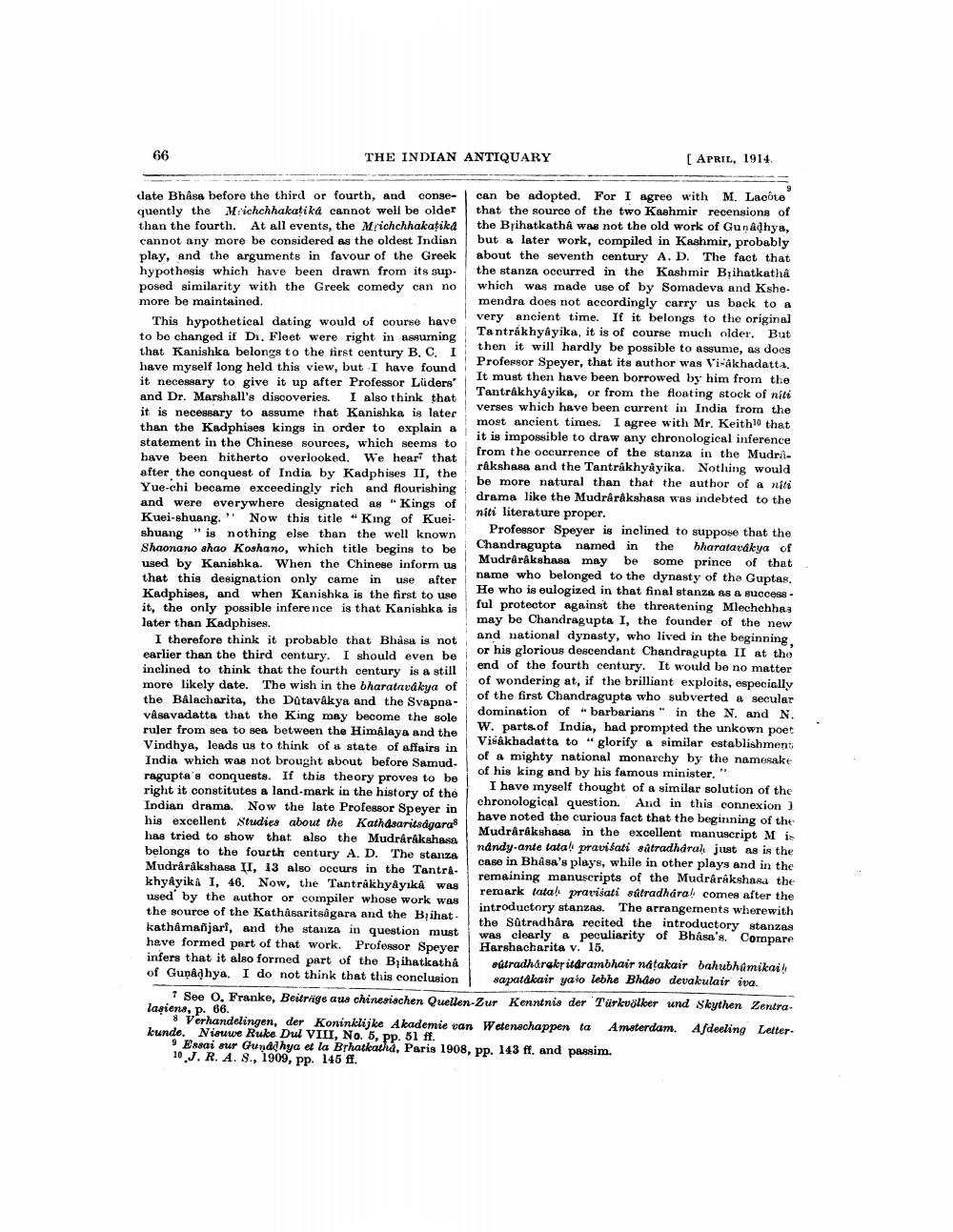________________
66
THE INDIAN ANTIQUARY
[ APRIL, 1914.
clate Bhåsa before the third or fourth, and conse- can be adopted. For I agree with M. Lacote quently the Michchhakatika cannot well be older that the source of the two Kashmir recensions of than the fourth. At all events, the Michchhakatika the Brihatkatha was not the old work of Gunadhya, cannot any more be considered as the oldest Indian but a later work, compiled in Kashmir, probably play, and the arguments in favour of the Greek about the seventh century A.D. The fact that hypothesis which have been drawn from its sup. the stanza occurred in the Kashmir Bihatkatha posed similarity with the Greek comedy can no which was made use of by Somadeva and Kshe. more be maintained.
mendra does not accordingly carry us back to a This hypothetical dating would of course have
very ancient time. If it belongs to the original
Tantrákhyayika, it is of course much older. But to be changed if D. Fleet were right in assuming
then it will hardly be possible to assume, as does that Kanishka belongs to the first century B. C. I
Professor Speyer, that its author was Vi-Akhadatta. have myself long held this view, but I have found
It must then have been borrowed by him from the it necessary to give it up after Professor Lüders' and Dr. Marshall's discoveries. I also think that
Tantrakhykyika, or from the floating stock of niti
verses which have been current in India from the it is necessary to assume that Kanishka is later
most ancient times. I agree with Mr. Keith that than the Kadphises kings in order to explain &
it is impossible to draw any chronological inference statement in the Chinese sources, which seems to
from the occurrence of the stanza in the Mudrahave been hitherto overlooked. We hear that
rakshasa and the Tantråkhyayika. Nothing would after the conquest of India by Kadphises II, the
be more natural than that the author of a niti Yue-chi became exceedingly rich and flourishing
drama like the Mudrårákshasa was indebted to the and were everywhere designated as "Kings of
niti literature proper. Kuei-shuang." Now this title "King of Kuei
Professor Speyer is inclined to suppose that the shuang "is nothing else than the well known Shaonano ahao Koshano, which title begins to be Chandragupta named in the bharatavakya of used by Kanishka. When the Chinese inform us
Mudråråkshasa may be some prince of that that this designation only came in use after
name who belonged to the dynasty of the Guptas.
He who is eulogized in that final stanza as a success - Kadphises, and when Kanishka is the first to use it, the only possible inference is that Kanishka is
ful protector against the threatening Mlechchhas later than Kadphises.
may be Chandragupta I, the founder of the new I therefore think it probable that Bhåsa is not
and national dynasty, who lived in the beginning
or his glorious descendant Chandragupta II at the earlier than the third century. I should even be
end of the fourth century. It would be no matter inclined to think that the fourth century is a still
of wondering at, if the brilliant exploits, especially more likely date. The wish in the bharatavákya of the Balacharita, the Datavakya and the Svapne
of the first Chandragupta who subverted a secular visavadatta that the King may become the sole
domination of barbarians" in the N. and N. ruler from sea to sea between the Himalaya and the
W. parts.of India, had prompted the unkown poet Vindhya, leads us to think of a state of affairs in
Visakhadatta to "glorify a similar establishment India which was not brought about before Samud.
of a mighty national monarchy by the namesake
of his king and by his famous minister." ragupta's conquests. If this theory proves to be
I have myself thought of a similar solution of the right it constitutes a land-mark in the history of the Indian drama. Now the late Professor Speyer in
chronological question. And in this connexion 1
have noted the curious fact that the beginning of the his excellent Studies about the Kathasaritsdgaras
Mudrårákshasa in the excellent manuscript Mis has tried to show that also the Mudrårákshasa
nandy-ante tata! pravisati sátradhdrah just as is the belongs to the fourth century A. D. The stanza
case in Bhasa's plays, while in other plays and in the Mudraråkshasa II, 13 also occurs in the Tantra.
remaining manuscripts of the Mudrårákshase the khyâyika I, 46. Now, the Tantråkhyâyıka was
reroark tatal pravisati sútradhára! comes after the used by the author or compiler whose work was
introductory stanzas. The arrangements wherewith the source of the Kathåsaritsagara and the Bihat.
the Satradhåra recited the introductory stanzas kathâmañjari, and the stanza in question must was clearly a peculiarity of Bhisa's. Compare have formed part of that work. Professor Speyer Harshacharita v. 15. infers that it also formed part of the Bihatkatha sutradhárakritarambhair natakair bahubhamikaih of Gupåd hya. I do not think that this conclusion sapatákair yalo lebhe Bhdeo devakulair iva.
T See O. Franke, Beiträge aus chinesischen Quellen-Zur Kenntnis der Türkvölker und Skythen Zentra. lasiens, p. 66.
# Verhandelingen, der Koninklijke Akademie van Wetenschappen ta Amsterdam. Afdeeling Letter. kunde. Nieuwe Ruke Dul VIII, No. 5, pp. 51 ff.
Essai sur Gunddhya et la Brhatkatha, Paris 1908, pp. 143 ff. and passim. 10.J. R. A.S., 1909, pp. 145 ff.




